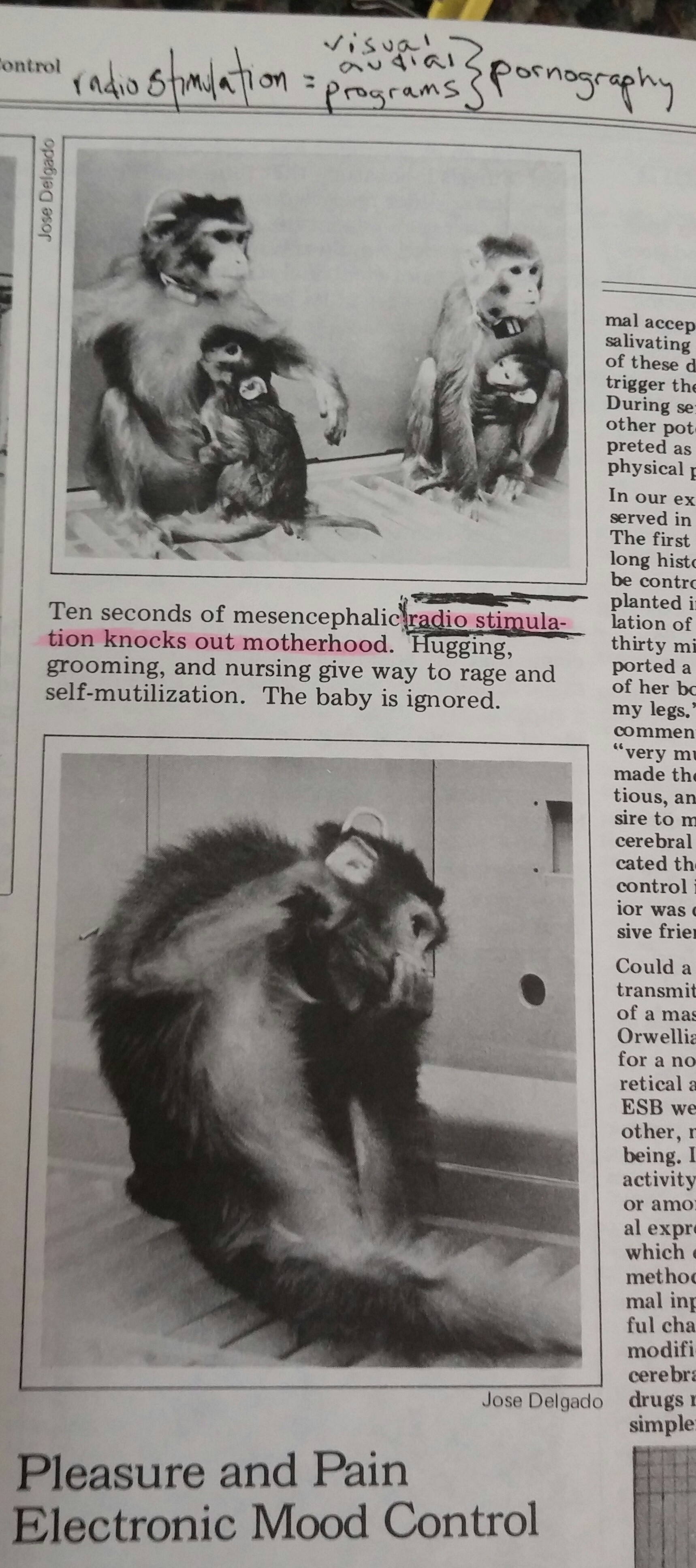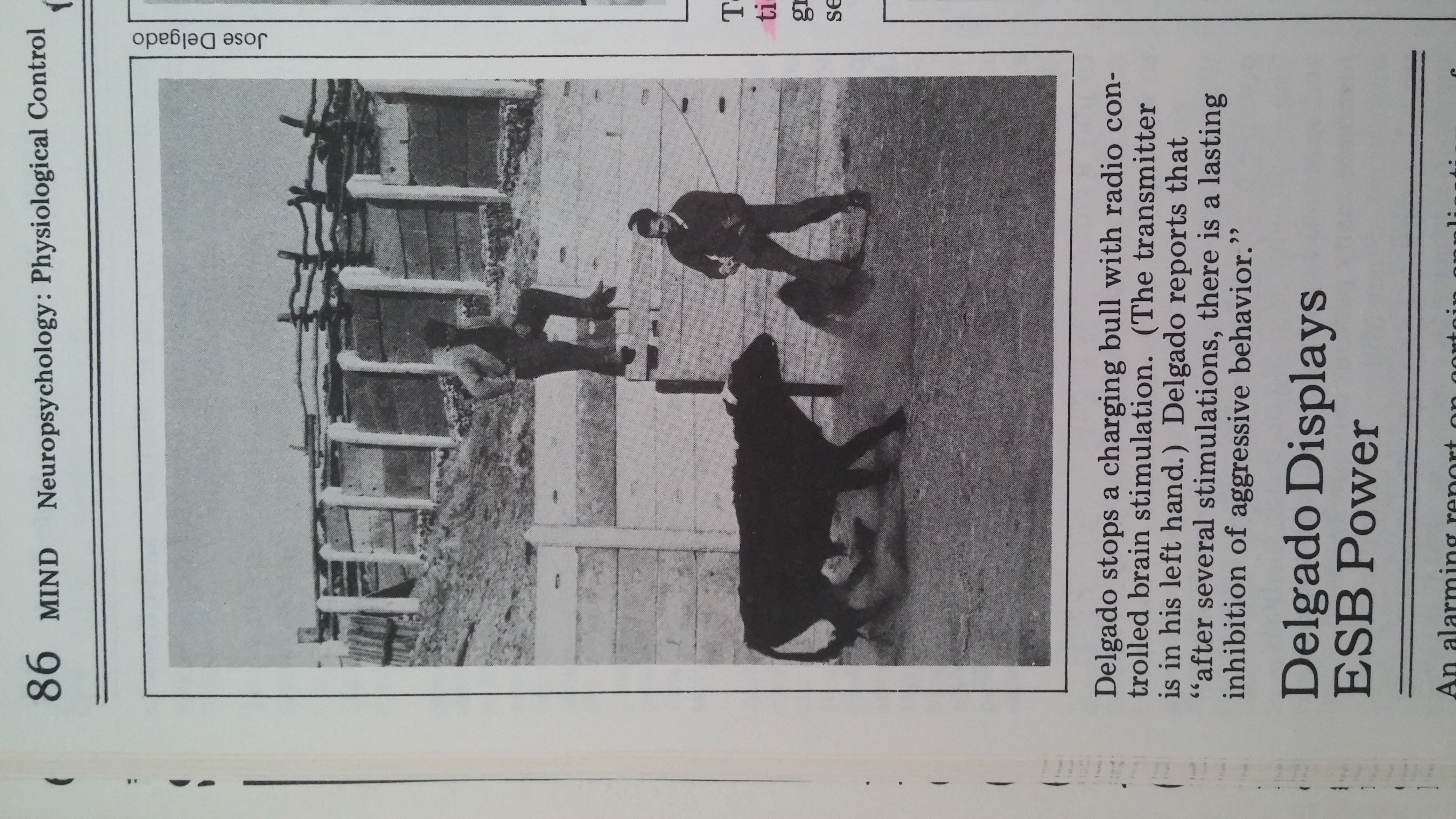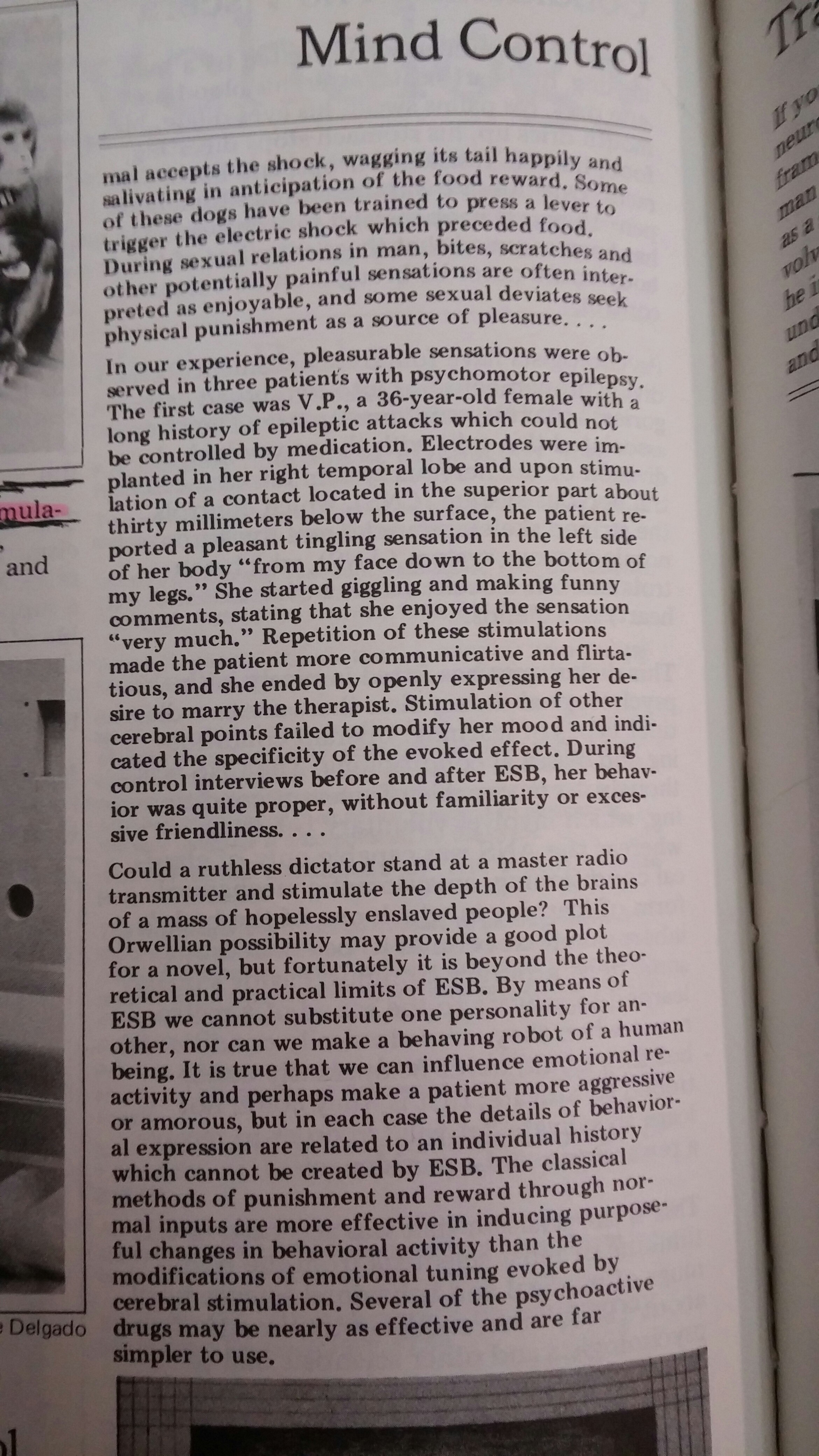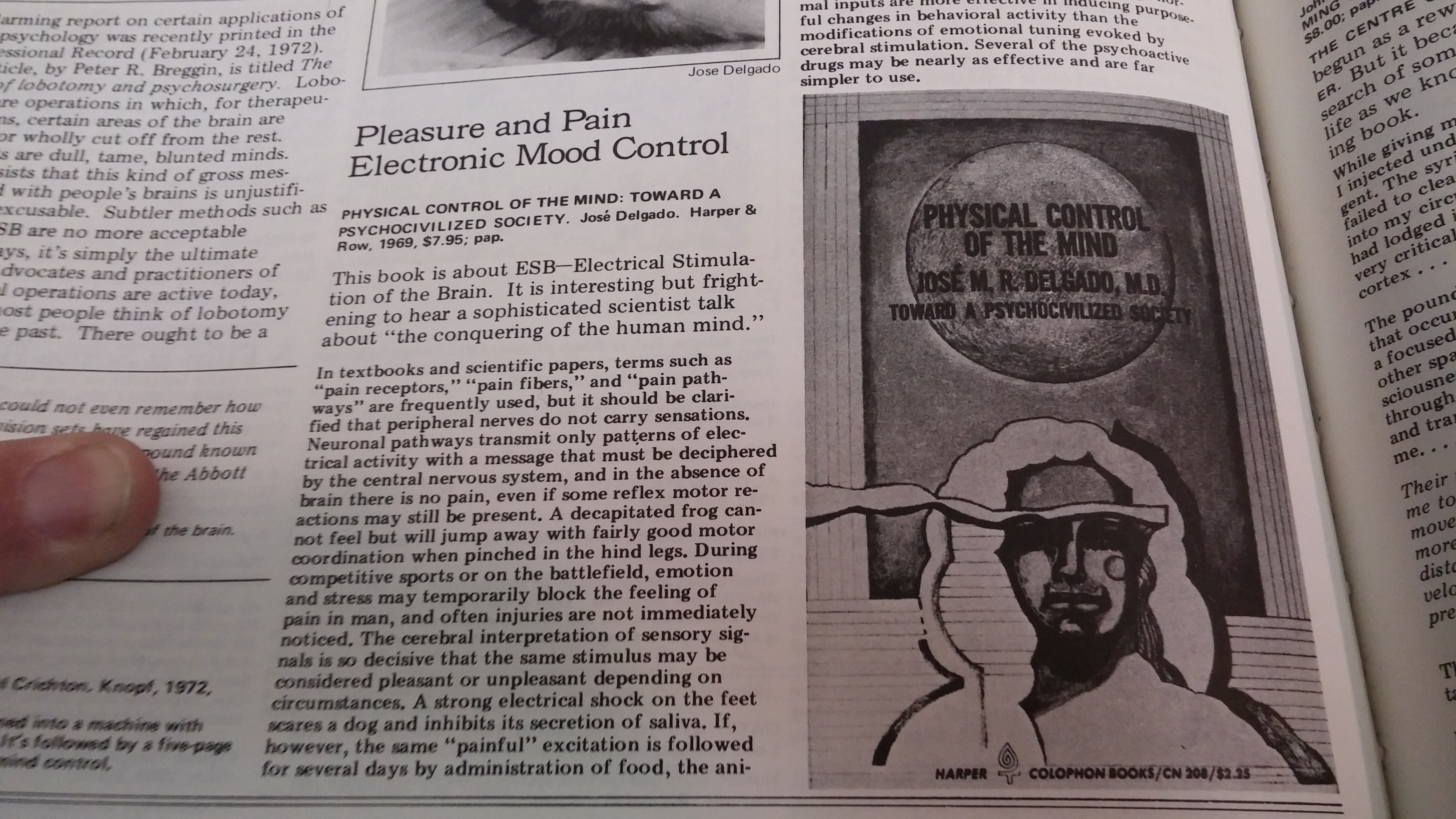It looks like you're using an Ad Blocker.
Please white-list or disable AboveTopSecret.com in your ad-blocking tool.
Thank you.
Some features of ATS will be disabled while you continue to use an ad-blocker.
8
share:
Electronic signals in Radio waves can control the Minds of animals!
the following material was published in 1971. imagine the wonders of electronic and radio behavior control THEY must have today!!

.... now take a moment to compare these two mother monkeys. the one on the left is clearly weirded out and the one on the right is clutching her baby. notice the radio transducers around their necks.



material is sourced from: Psychosources: A Psychology Resource Catalog
the following material was published in 1971. imagine the wonders of electronic and radio behavior control THEY must have today!!

.... now take a moment to compare these two mother monkeys. the one on the left is clearly weirded out and the one on the right is clutching her baby. notice the radio transducers around their necks.
Ten seconds of mesencephalic radio stimulation knocks out motherhood. Hugging, grooming, and nursing give way to rage and self-mutilation.... the baby is ignored.

Delgado stops a charging bull with radio controlled brain stimulation. (The transmitter is in his left hand.) Delgado reports that "after several stimulations, there is a lasting inhibition of aggresive behavior.


material is sourced from: Psychosources: A Psychology Resource Catalog
Oh, yes....Its all very real......
They have been at it since ww2.....with a vengeance....
What they ARE capable of could clearly be the reality some gangstalked people claim it is.....
They have been at it since ww2.....with a vengeance....
What they ARE capable of could clearly be the reality some gangstalked people claim it is.....
As a kid in the 60s growing up into the 80's, I was profoundly disturbed by the regular site of apparently crazy persons with signs and sandwich
boards warning of "Silent Radio."
They wrote lengthy warnings going into detail of radio frequency experiments being conducted on them and others.
My older brother just laughed it off bit intuitively I knew these people were warning us of something very real.
Problem is its too much for most people to consider. They go into default denial.
They wrote lengthy warnings going into detail of radio frequency experiments being conducted on them and others.
My older brother just laughed it off bit intuitively I knew these people were warning us of something very real.
Problem is its too much for most people to consider. They go into default denial.
yes, ask the around 30000 people world-wide with implanted DBS (deep brain stimulators, mainly for Parkinson's and other neurological diseases)
systems how they feel being 'under control' by the PTB?. if we add to that the amount of people walking around with some sort of implantable
electronic device, (pacemakers, Vagus stimulators, etc), well, there must be a couple of million by now. Guess the 'secret goverment' doesn't have
much sucess with so many 'secret agents' implanted with these electronic mind-controls, looking at the state of the world....
Or just maybe, all those implantable devices are not being used to control people, just maybe some things are being used for good as well.
Or just maybe, all those implantable devices are not being used to control people, just maybe some things are being used for good as well.
a reply to: tgidkp
Oh yes, this is a thing and has been for quite some time. Now, they're telling us they can do it over the internet.
And as can be seen, have no compunction against it's use.
Not to mention everything else tied in.
a reply to: Hellhound604
You are correct, there are numerous examplez of beneficial use of this technology.
That does not, however, preclude it's use in nefarious goals, does it?
Oh yes, this is a thing and has been for quite some time. Now, they're telling us they can do it over the internet.
And as can be seen, have no compunction against it's use.
Not to mention everything else tied in.
a reply to: Hellhound604
You are correct, there are numerous examplez of beneficial use of this technology.
That does not, however, preclude it's use in nefarious goals, does it?
edit on 24-11-2014 by jadedANDcynical because: (no reason
given)
First came the animal studies...
We all know what happened after that.
I've always felt that people who accumulate heavy metals in their body, eventually turn into some type of antenna.
For what, I don't know.
We all know what happened after that.
I've always felt that people who accumulate heavy metals in their body, eventually turn into some type of antenna.
For what, I don't know.
back when I ran the maintenance program at the NSA satellite earth terminals, on more than one occasion I had the thought about what is REALLY the
purpose and content of the microwave signals we were broadcasting.??
I knew quite well that our signals carried broadband data across continents. even still... I never felt totally certain about it.
so, I know quite a bit about radio signalling. and it has always bothered me to hear the "smart" people dismiss this type of technology out of hand.
I knew quite well that our signals carried broadband data across continents. even still... I never felt totally certain about it.
so, I know quite a bit about radio signalling. and it has always bothered me to hear the "smart" people dismiss this type of technology out of hand.
Yes. And 45 years have transpired since those experiments. Plus, now, nearly everyone has a transmitter in their pocket, their lap, or on the desk
in the same room. RF is very wide, and the possibilities that different wavelengths have different effects is likely. The wave length of light that
induces vitamin D production in the skin of humans is fairly narrow. Intensity can also clearly make a difference, just as too little light does not
allow the human eye to see, but too much blinds it. Good article.
originally posted by: eisegesis
First came the animal studies...
We all know what happened after that.
I've always felt that people who accumulate heavy metals in their body, eventually turn into some type of antenna.
For what, I don't know.
Have you ever tried it?
I'm a particularly strong antenna. You can use your hand pressed onto the contacts where an antenna would plug in and you work fine as well..
Often I see this game as one of frequencies and dimensions higher than 4.
Some things act as carrier waves. Some chemicals.
Try and not get set into patterns or habits or addictions. Most of the mind control out there is subconscious desires.. It's the hardest one to see or know you have, everyone has lots of it, but it's also the kind you have control over..
When it comes to microwaves and radio waves and all that, at least your signal is coming from within the brain and there's would have to come from outside te skull. That puts you at a great advantage..
Anyway..
We are animals. And we also act as antennas.
There is research where iron particles were discovered to occur naturally in the human sphenoid bones, as well as microscopic bio-iron crystals in human brain tissue.
Magnetic bones in human sinuses
Caltech Scientists Find Magnetic Particles in Human Brains
Magnetoception
Link
A tiny compass in your mind can certainly be affected by radio waves from long distances away. Take the rise in aluminum toxicity and in theory, humans could certainly act as either a receiver or transmitter.
I think they like turning us into raging egomaniacs. Its easier to predict our course of action. Instead of realizing who the real enemy is, we end up fighting each other and eat/drugs/sleep our life away.
There is research where iron particles were discovered to occur naturally in the human sphenoid bones, as well as microscopic bio-iron crystals in human brain tissue.
Magnetic bones in human sinuses
We report here that bones from the region of the sphenoid/ethmoid sinus complex of humans are magnetic and contain deposits of ferric iron. The possible derivations and functions of these deposits are discussed.
Studies on the interaction of magnetic fields and biological organisms have centered on the influence of applied magnetic fields on the physiology and behavior of organisms, including humans, and a search for magnetic sources within the organisms themselves. Evidence continues to accumulate that a wide range of organisms, from bacteria to vertebrates, can detect and orient to ambient magnetic fields.
Caltech Scientists Find Magnetic Particles in Human Brains
In many other species, such as pigeons, salmon and whales, the magnetic particles allow the organisms to navigate in Earth's magnetic field, providing an inborn sense of direction. But it is not yet clear whether humans have the same ability, Kirschvink said.
"We don't know what the magnets do or where they hide in cells," he added, but their discovery could help explain the reported link between cancer and the electromagnetic fields produced by power lines and appliances.
Magnetoception
An unequivocal demonstration of the use of magnetic fields for orientation within an organism has been in a class of bacteria known as magnetotactic bacteria. These bacteria demonstrate a behavioural phenomenon known as magnetotaxis, in which the bacterium orients itself and migrates in the direction along the Earth's magnetic field lines. The bacteria contain magnetosomes, which are particles of magnetite or iron sulfide enclosed within the bacterial cells.
Link
A tiny compass in your mind can certainly be affected by radio waves from long distances away. Take the rise in aluminum toxicity and in theory, humans could certainly act as either a receiver or transmitter.
I think they like turning us into raging egomaniacs. Its easier to predict our course of action. Instead of realizing who the real enemy is, we end up fighting each other and eat/drugs/sleep our life away.
new topics
-
Gaetz withdraws from attorney general consideration
US Political Madness: 2 hours ago -
Bridgewater Triangle
General Chit Chat: 2 hours ago -
Is Russia Using a New Type of Beam Weapon Against Ukraine?
Weaponry: 3 hours ago -
Here is why Western leaders in NATO have zero fear of nuclear warfare. At all. Zero.
World War Three: 5 hours ago -
International Criminal Court Issues Arrest Warrant For Netanyahu
Breaking Alternative News: 5 hours ago -
racist rant, but she made the arguement to get rid of DEI
US Political Madness: 7 hours ago -
Well we know Putins ICBMs won't fail in their silos
World War Three: 7 hours ago
top topics
-
Well we know Putins ICBMs won't fail in their silos
World War Three: 7 hours ago, 12 flags -
racist rant, but she made the arguement to get rid of DEI
US Political Madness: 7 hours ago, 9 flags -
International Criminal Court Issues Arrest Warrant For Netanyahu
Breaking Alternative News: 5 hours ago, 8 flags -
Is Russia Using a New Type of Beam Weapon Against Ukraine?
Weaponry: 3 hours ago, 8 flags -
Gaetz withdraws from attorney general consideration
US Political Madness: 2 hours ago, 5 flags -
Why isn't Psychiatry involved?
Social Issues and Civil Unrest: 13 hours ago, 4 flags -
Here is why Western leaders in NATO have zero fear of nuclear warfare. At all. Zero.
World War Three: 5 hours ago, 4 flags -
Bridgewater Triangle
General Chit Chat: 2 hours ago, 4 flags -
Help in song interpretation
Music: 15 hours ago, 3 flags
active topics
-
Well we know Putins ICBMs won't fail in their silos
World War Three • 84 • : Xtrozero -
International Criminal Court Issues Arrest Warrant For Netanyahu
Breaking Alternative News • 32 • : JJproductions -
Gaetz ethics investigation results "hacked".
US Political Madness • 35 • : marg6043 -
Mood Music Part VI
Music • 3711 • : SLAYER69 -
Russia Ukraine Update Thread - part 3
World War Three • 6855 • : Freeborn -
Is Russia Using a New Type of Beam Weapon Against Ukraine?
Weaponry • 12 • : CarlLaFong -
-@TH3WH17ERABB17- -Q- ---TIME TO SHOW THE WORLD--- -Part- --44--
Dissecting Disinformation • 3340 • : Thoughtful3 -
How can you defend yourself when the police will not tell you what you did?
Posse Comitatus • 102 • : Oldcarpy2 -
Gaetz withdraws from attorney general consideration
US Political Madness • 9 • : VariedcodeSole -
Here is why Western leaders in NATO have zero fear of nuclear warfare. At all. Zero.
World War Three • 5 • : ARM19688
8
